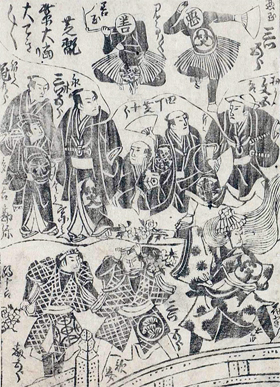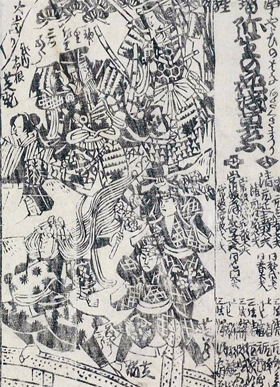| YAYOI NO HANA ASAKUSA MATSURI |
| Play titles | Yayoi no Hana Asakusa Matsuri Sakura Doki Onna Gy˘retsu |
| Authors | Segawa Jok˘ II (lyrics) Kiyomoto Saibŕ (music) Fujima Kanjűr˘ I (choreography) |
| History |
The 3-part Kiyomoto/Tokiwazu/Nagauta-based dance "Yayoi no Hana Asakusa Matsuri" was staged for the first time in the 3rd lunar month of 1832 at the Nakamuraza at the end of the drama "Sakura Doki Onna Gy˘retsu", starring Band˘ Mitsugor˘ IV (who celebrated his shűmei) and Nakamura Shikan II in the leading roles. |
| Structure |
The dance "Yayoi no Hana Asakusa Matsuri" was divided into 3 parts:
This dance is still sometimes performed in its entirety but the first half of the second part, "Sanja Matsuri", is frequently staged independently. |
| Key words |
Aku Asakusa Asuka Jidai Hakusai Hayagawari Hengemono Hinokuma Hamanari Hinokuma Takenari Jingű K˘g˘ Kiyomoto K˘rai Men Miyatogawa Nagauta ďjin Tenn˘ Ry˘shi Sanja Matsuri Shakky˘ Shakky˘ (N˘) Shakky˘mono Shinra Shishi Shishimono Shosagoto Sumidagawa Takenouchi no Sukune Tokiwazu Tsűjin Yabo Daijin Yayoi Zen |
| Summary |
Empress Jingű and General Takenouchi no Sukune The curtain opens to reveal gala festival decorations, with a float in the center bearing the 2nd century Empress Jingű and her general Takenouchi no Sukune. They tell the story of their famed subjugation of the Three Kingdoms of Korea: Shinra, K˘rai, and Hakusai. According to the legend, Empress Jingű was pregnant at the time of battle, and she placed a stone under her sash to keep her from giving birth until the battle was won. This was the final successful military expedition for both Empress Jingű and Takenouchi no Sukune. After this battle, it is said, she gave birth to Emperor ďjin, and reigned by his side as regent for 69 years with Takenouchi no Sukune as her Grand Minister. This was a period of uninterrupted peace and prosperity for Japan. According to the legend, Empress Jingű died at the age of 110 and Sukune at the age of 280. The Spirit of Good and the Spirit of Evil The dancers disappear behind a large white cloth up stage, and that cloth suddenly becomes the sail of a boat on the Miyato River. Almost as suddenly, the dancers appear once more, now dressed as the river fishermen Hinokuma Hamanari and his younger brother Hinokuma Takenari. They are casting their net into the river when a dark cloud suddenly descends over their boat. The cloud is bearing the Spirits of Good (zen) and Evil (aku), which possess the two fishermen. This is symbolized by Hamanari taking a circular mask from the cloud bearing the character for Good (zen) and Takenari taking the one with the character for Evil (aku) and placing the respective masks over their own faces. They perform a humorous dance depicting the manner in which Good and Evil attempt to influence each other, with Good, of course, losing out in the end. The Man about Town and the Wealthy Bumpkin The Good Spirit jumps into the boat and rows off stage. The scene changes to the pleasure quarters as the Evil Spirit dances in triumph. The dancer playing the Good Spirit now reappears as a tsűjin, a well-educated well-mannered smart and sophisticated Edo man very familiar with the pleasure quarters of his city. The tsűjin is on his way to enjoy himself. The Evil Spirit dances with the tsűjin for a time in an atmosphere of mutual understanding of the pleasures of decadent living. The Evil Spirit disappears and the tsűjin continues to dance, showing off his fine clothes and accoutrements and describing the food and drink and other joys he is looking forward to during the evening to follow. A wealthy countryside bumpkin (yabo daijin) appears in his path. The yabo daijin is in the big city for the first time, and the dance duet that follows amusingly reveals the differences in character between the two men. The Stone Bridge The wealthy bumpkin and the man about town strike a pose on a lift and descend out of sight and the scene changes to a stone bridge covered with snow and surrounded by red and white peonies. Two Lion Spirits (shishi) appear and perform a vigorous dance based on the N˘ play titled "Shakky˘" (literally "Stone Bridge"). |
 |
 |
|
"Yayoi no Hana Asakusa Matsuri" in the 3rd lunar month of 1832 at the Nakamuraza (illustrations coming from an ehon banzuke) |
|
|
|
| Contact | Main | Top | Updates | Actors | Plays | Playwrights | Programs | Links | FAQ | Glossary | Chronology | Illustrations | Prints | Characters | Derivatives | Theaters | Coming soon | News |